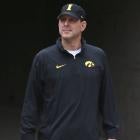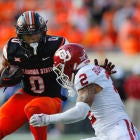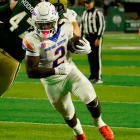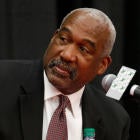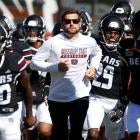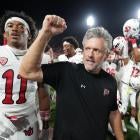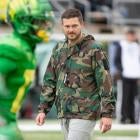PARADISE VALLEY, Ariz. -- J.T. Barrett was more than watching Sunday when a 347-pound defensive tackle made NFL history. He was totally engaged.
Kansas City's Dontari Poe became professional football's heaviest player ever to throw for a touchdown. The two-yard jump pass that finalized a 33-10 win was half pirouette, half circus act.
And all viral if you were anywhere near social media.
"That was lovely. I loved every bit of it," Barrett said gleefully. "Every part of it. My man was 340 and change. He executed quite nice."
Barrett has been there before, as has just about every quarterback who has played for Urban Meyer. To a man, they have been trained to beat teams as much (or more) with their legs as with their arms.
Certainly no other coach this century has developed dual-threat quarterbacks at such a high level. When Barrett leads the Buckeyes out Saturday night in the Fiesta Bowl, he will already be the sixth quarterback under Meyer to start for an undefeated and/or national championship team.
Not all of them have attempted a jump pass. They are definitely the select football offspring of their coach who started to renovate the position the year he became a head coach in 2001 at Bowling Green.
"We had a plan," Meyer recalled. "I remember sitting in a room with [assistants] Gregg Brandon, Dan Mullen and the staff. We were putting together this offense. We were either going to go wishbone or spread.
"With the wishbone, you don't really fill a stadium all the time."
Good choice, then. A part-time running back named Josh Harris went from reluctant participant to one of three quarterbacks to lead a team in rushing for Meyer.
"He was a guy who didn't really love it when we first got there," Meyer said. "As a matter of fact, he asked me one time, 'I don't understand why you guys put so much time in this.'"
What emerged from that conversation has become the base philosophy of modern offensive college football. With very few exceptions everywhere, a quarterback also has to be able to run.
The widespread use of the dual-threat signal-caller is less than a generation old. And certainly Meyer isn't its inventor -- he gives proper credit to his predecessors -- but perhaps no other coach of this age has done more to re-imagine the position.
"There was a rumor you couldn't run this offense. It was so-called 'finesse,'" said Arizona's Rich Rodriguez, one of the godfathers of the spread offense. "There was nothing finesse about it. It was different way of getting 11 guys involved instead of 10."
At their best, Meyer's quarterbacks can disguise plays like their single-wing predecessors from decades past. The option concepts harken back to the best wishbone quarterbacks.
They're always going to be tough runners. Every one of Meyer's 15 teams have run it more than passed it. Ten of 15 have had more rushing than passing scores. His quarterbacks have been stunningly consistent.
In the 10 years prior to Ohio State, Meyer's quarterbacks ran it 16.2 times per game. Buckeyes' QBs under Meyer have averaged 17.2 carries in his five seasons.
Modern spread offenses demand some form of that production, in part, because of Meyer. It's safe to say each coach playing for a national championship this weekend will use some of concepts Ohio State's coach has developed.
Who would have thought Nick Saban would go all-in on the spread?
"We're always going to have a dynamic quarterback," said Clemson's Dabo Swinney, who probably has the most dynamic quarterback in the country in Deshaun Watson.
Watson's 2015 season was a nod at Meyer's spread innovation. He became the first major-college quarterback in history to throw for at least 4,000 yards and rush for at least 1,000.
That leads to one small not-so-small question: Would a Watson even be possible today if the overwhelming majority of college coaches today weren't playing, developing and recruiting dual-threat quarterbacks?
Maybe not. Swinney revealed Thursday at the Fiesta Bowl's media day that as a Clemson assistant he traveled to Utah in 2004 to get ideas from the offense Meyer was developing with the Utes.
Back then, a young Alex Smith was in the process of making Utah (13-0) the first BCS buster. That team eventually played right here in the Fiesta Bowl.
"We were trying to study ... how they were incorporating their quarterback," Swinney recalled. "Obviously Urban went to Florida the next year. I was recruiting Tim Tebow as an assistant at Clemson. He was recruiting Tebow. Then when he got him, things changed a little bit."
They already had. The magnificent Vince Young helped Texas win the 2005 national championship. Things snowballed from there.
Tebow, you might recall, was at times basically a fullback playing quarterback. Braxton Miller went from leading the Buckeyes in rushing as a QB in 2012 to its third-leading receiver in 2015 when Barrett and Cardale Jones developed.
Barrett needs 153 rushing yards to make it three times since 2012 an Ohio State quarterback has thrown for 2,000 and rushed for 1,000.
"They have to be very select," Meyer said of his quarterbacks. "You can't have a bad day. I always tell people that, if you have a bad day at receiver, you replace them. You can't have a bad day as a quarterback."
This fad isn't near over. Meyer is correct to acknowledge the likes of Rodriguez, Chip Kelly and SMU coach Chad Morris, formerly Swinney's offensive coordinator.
Rodriguez had been running his quarterbacks since his days 25 years ago at Glenville (West Virginia) State. When Rich Rod moved on to Tulane and Clemson as a coordinator, the secret buried in Division II was out.
Coaches -- including Meyer -- began beating a path to his office door. Rodriguez' West Virginia teams developed a reputation for a punishing running game -- overseen by a running quarterback -- out of the spread.
While at Clemson under Tommy Bowden, Rodriguez once flipped on his TV to find Randy Walker at Northwestern had basically copied his entire playbook.
It was unsettling, not unethical. Walker had paid a visit to Rich Rod and Clemson in the offseason.
"He took the offense verbatim. I mean verbatim," Rodriguez said. "I'm watching Northwestern play and I'm hearing our same play calls."
That makes sideshows like the jump pass possible at any time under Meyer. The mere threat of the quarterback to run usually sells the fake. There's a jab step toward the line before a basketball-like jump shot/throw into the end zone.
"We practice it every now and then to keep it fresh," Barrett said.
Tebow brought it to the masses against LSU in 2006.
But Meyer already had used it in 2003 at Utah.
A backup tight-end named Ben Moa beat Air Force in triple overtime with a jump pass. How did that ever come about?
"Just screwing around," Meyer said. "Dan Mullen and I."
It should be noted that Mullen has moved from Meyer's side as his offensive coordinator to develop Dak Prescott and Nick Fitzgerald at Mississippi State.
Prescott is a rookie sensation with the Dallas Cowboys. Fitzgerald just rushed for the fourth-highest single-season total by an SEC quarterback.
There's a pattern here.
It also should be noted that Barrett is up for anything Saturday night. Forget jump passes. A quantum leap already has been made.
"That's part of his game plan," the quarterback said. "That's Coach Meyer scheming it up in his office."













